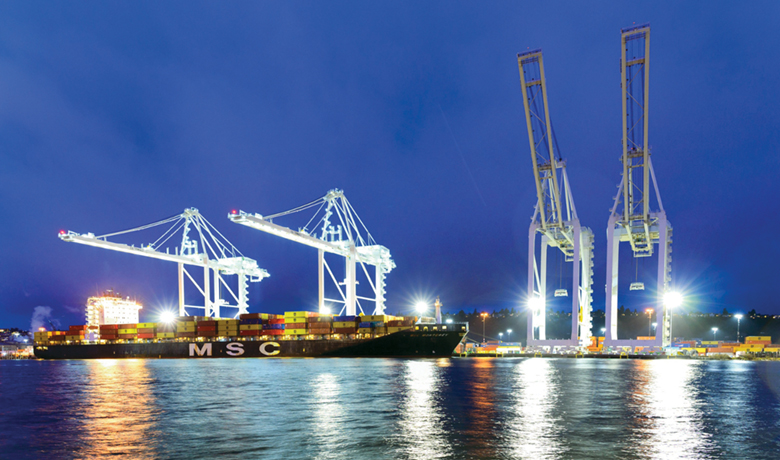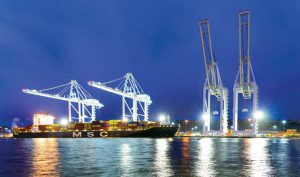
As consumer demands grow, so do the vessels that bring those goods to West Coast ports.
Throughout the U.S. and Canadian West Coasts, seaports are in the midst of planning and building for that growth, whether it’s outfitting terminals with the tallest cranes and newest cargo-handling equipment, or dredging harbors to ensure that these mega-ships can safely arrive. The COVID-19 pandemic-driven congestion at larger seaports has only highlighted the need for more capacity.
Here’s a look at a number of projects port officials are planning, or in some cases, are already in progress.
PORT OF LOS ANGELES
The nation’s busiest seaport is bustling with a bevy of various infrastructure projects.
In February, the port, the International Longshore and Warehouse Union and the Pacific Maritime Association broke ground on a Goods Movement Training Campus, which would provide training for 900 longshore workers and mechanics, as well as maintenance and repair.
Meanwhile, construction is also expected to start this year on State Route 47/Vincent Thomas Bridge and Front Street/Harbor Boulevard Interchange Reconfiguration project, which would help improve traffic flow on a significant transportation corridor for cargo.
The $70.5 million project would remove a westbound off-ramp from the bridge on the south side with a new off-ramp on the north side, reconfigure the westbound on-ramp onto the SR-47 and I-110 connector, alter the westbound off-ramp onto Harbor Boulevard and the eastbound on-ramp onto the bridge toward Terminal Island, according to the port.
Work is also set to begin in July on a new $44.8 million marine-oil platform at the Shell Oil Terminal. Scheduled to be completed in 2024, the project calls for removing timber wharves and building and operating a new wharf at Berth 168. In addition, improvements are planned for the link between the new loading platform and landside pipelines and utilities.
Los Angeles harbor officials are wrapping up the design of a $25.7 million marine-oil platform at the PBF Energy Oil Terminal. The project at Berth 238 would involve a new unloading platform, 125 feet by 58 feet, berthing and mooring dolphins, catwalks and access ramp and removal of two unloading platforms at Berths 238 and 239. The port hopes work could begin in July 2023.
The port is also bolstering its rail capacity, including a $17.29 million project that adds a second mainline track, which would close a small gap in track between the West Basin area of the port and the Alameda Corridor. About 5,000 track feet of rail will be built alongside the San Pedro main track between John S. Gibson Boulevard and McDonald Avenue, along with changes to the West Basin ICTF (Intermodal Container Transfer Facility) lead track and relocating utilities.
NORTHWEST SEAPORT ALLIANCE
The Northwest Seaport Alliance kicked off 2022 with the arrival of MSC Monterey, the first ship to arrive at the new and improved Terminal 5 with its four new super-post Panamax cranes purchased by SSA Marine.
This is a milestone moment for the alliance, which started the terminal’s modernization program in 2016 to broaden its capacity for cargo and accommodate the biggest trade ships.
Phase One began in July 2019 with renovations to the terminal, an estimated half-billion dollar investment by the alliance and SSA Marine. The work called for reconfiguring berths to accommodate bigger cranes, on-dock rail, 1,500 refrigerated plug-ins and the ability to provide shore power, the alliance said. SSA’s Super-post Panamax cranes, at 316 feet, each feature an outreach boom of 240 feet and the ability to lift 65 tons, according to NWSA.
Meanwhile, the second phase of the modernization program, focused on operations in the south berth, is in progress and is anticipated to be done in mid-2023.
When fully operational, Terminal 5 will have an additional 185 acres of capacity.
The upgrades will not only help with import business, but the improved terminal could attract more Midwest and eastern Washington agriculture exporters interested in shipping goods overseas, the alliance said.
“The opening of Terminal 5 will add an additional berth to our gateway at a time when the supply chain is under increased pressure,” said Port of Tacoma Commission President and NWSA Co-Chair Don Meyer. “We are the only gateway bringing additional berth capacity to our harbors on the West Coast at this critical time. By adding additional deep-water terminal space, we can serve the largest vessels in the industry and increase cargo volumes that benefit our local, state and regional economy for years to come.”
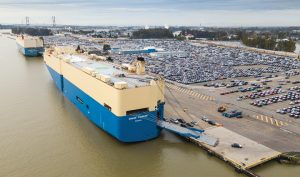
PORT OF VANCOUVER, B.C.
This British Columbia seaport is making major moves to grow its market share. In October, the Vancouver Fraser Port Authority announced an agreement with terminal operator WWL Vehicle Services Canada, Ltd. to upgrade the Annacis Auto Terminal in Delta.
The Transport Canada-funded Annacis Auto Terminal Optimization Project aims to enhance the terminal’s efficiency and capability to meet future demand for more vehicle imports, particularly hybrid and energy-efficient vehicles.
The project seeks to turn a pair of port automobile terminals into one terminal at the Annacis site, with the Richmond Auto Terminal eventually becoming available for other port-related business.
The upgrades—which also include expanding a pair of rail yards, putting in charging stations for electric vehicles and removing some buildings to construct a new vehicle processing facility—would be a big help to the Annacis Auto Terminal and Richmond Auto Terminals, which are already running at maximum capacity.
When done, the terminal could process as many as 480,000 vehicles annually.
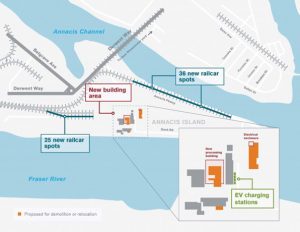
“With nearly 100% of all Asian-manufactured vehicle imports coming through the Port of Vancouver destined for the Canadian market, the Annacis Auto Terminal Optimization Project will help address post-pandemic growth in the auto sector and emerging electric vehicle demand—all within existing land use,” said Jennifer Natland, acting vice president of real estate at the port authority.
Meanwhile, the port authority in November opened an improved, deepened Mountain Highway underpass near Lynnterm Terminal in the District of North Vancouver.
Funded by Transport Canada and the port, the project increases cargo flow through Greater Vancouver in a sustainable way that eases impacts to neighborhoods.
The project—in partnership with Western Stevedoring, the District of North Vancouver, Canadian National Railway and the Squamish Nation indigenous government—also catered to pedestrians with new sidewalks along the underpass and between Dominion and Bay streets.
It also helps to expand capacity for oversized cargo at Lynnterm Terminal, something that Dave Lucas, president of North Vancouver-based Western Stevedoring, said is a big help in attracting and processing oversized imported cargo for big projects in Western Canada that used to go through U.S. ports.
PORT OF PRINCE RUPERT
In February, the Prince Rupert Port Authority, the governing body of Canada’s third-biggest seaport, announced plans for a number of major infrastructure projects aimed at enhancing Canada’s ability to move vital cargo and make the port more resilient to supply-chain impacts.
One involves the two-phase expansion of DP World’s Fairview Container Terminal, which is expected to add 1.6 million twenty-foot equivalent units (TEU)) when Phase 1 is completed in July and 1.8 million TEUs after Phase 2 in 2024.
“The DP World Fairview Terminal already offers the fastest connection from Asia to North America, and this expansion of the Prince Rupert Gateway will provide the infrastructure necessary to meet increasing trade-growth forecasts,” said Maksim Mihic, CEO and general manager of DP World (Canada).
Meanwhile, the new Fairview-Ridley Connector Corridor is expected to be done later this spring, enabling container trucks to be rerouted from local transload and customs facilities to Fairview Container Terminal.
For another project, DP World, Ray-Mont Logistics and the port are teaming up to develop a modern export logistics facility on Ridley Island, providing “scale, speed and terminal integration that will become the new standard for export transload services on the West Coast,” according to the port.
For inbound cargo, the Metlakatla Development Corporation and the port are working to develop the South Kaien Import Logistics Facility on 34 acres close to Fairview Container Terminal, a move to bolster cargo growth by 2030.
In December, Canadian firm Wolverine Terminals started construction that would support a much-needed marine fuel-delivery service at the port, so vessels won’t have to stop at other ports to fuel up.
The project calls for a fuel distribution barge of 256 feet with a capacity of about 4,800 metric tons, along with a 466-foot rail barge that could hold up to 24 rail tank cars on deck and a marine berth able to secure both barges. Wolverine expects fuel delivery operations to start at the port in early 2023.
PORT OF ALASKA
After a few delays, the Port of Alaska is wrapping up construction on a new Petroleum and Cement Terminal, a pile-supported dock near ABI’s cement-storage dome.
The new terminal, which will replace the aging Petroleum Oil Lubricants Terminal 1, is the port’s main petroleum terminal and the state’s only dock with a pneumatic, bulk cement unloading and transfer system.
Pacific Pile and Marine completed all in-water work on the terminal last October. Beluga whale activities and materials issues, however, slowed progress so much that the port had to delay dredging silt that built up in the PCT berth during construction. Winter weather ended dredge operations for the season, according to port spokesman Jim Jager.
Supply-chain issues also delayed final electrical work and other on-dock projects.
Luckily, those issues have largely been resolved and the port expects Pacific Pile and Marine to finish most of the PCT work in the coming weeks, with a soft opening of the new terminal for barge service planned for mid-March, Jager said.
Depending upon weather and ice conditions, the port tentatively plans to dredge the PCT berth in late April/early May and open the new terminal for full service by early June, Jager said.
PORT OF COOS BAY
Two major projects may soon be under way at the Oregon International Port of Coos Bay.
The port is still in discussion with Missouri-based firm NorthPoint Development on building a multimodal container facility on the North Spit and hopes to execute a formal agreement by mid-March, according to port spokeswoman Margaret Barber.
“Things are moving along very well with that project, and it seems to be garnering a broad base of support as a project that can serve as a necessary release valve for the supply-chain issues we have been experiencing over the past two years,” Barber said.
When completed, the new terminal is expected to handle over 1 million 40-foot containers annually via the Coos Bay Rail Line, allowing for quicker turn times and fewer truck trips, the port said.
Meanwhile, Coos Bay officially acquired the former Georgia Pacific Mill site in January from St. Louis-based CDC Inc.
Port officials plan to reimagine the property as a bulk and breakbulk terminal and are pursuing business opportunities for the space, Barber said. The Port of Coos Bay hopes the site could accommodate some cargo as early as mid-2023 after the first phase of construction.
PORT OF GRAYS HARBOR
Ag Processing Inc, the Port of Grays Harbor’s biggest marine terminal customer, has announced plans to construct a new, modern soybean processing plant near David City, Nebraska.
This is major news for the port, where AGP operates a storage and export facility at Terminal 2.
“The soybean processing industry is experiencing tremendous growth and we believe a facility in East Central Nebraska is strategically located to serve our cooperative members and their farmer-owners,” said AGP’s chairman, Lowell Wilson. “Maintaining a strong cooperative system is vital to agricultural producers and our rural communities.”
AGP’s CEO Chris Schaffer said the David City location will improve the company’s ability to market soybean meal to the Pacific Rim through AGP’s export terminal in Aberdeen, Wash..
“AGP is currently considering investments that will significantly increase our export capabilities to meet the expected growth in domestic protein supply,” Schaffer said.
Meanwhile, the port is advancing infrastructure plans to meet AGP’s needs.
“We anticipate needing to improve fender systems and expand rail capabilities within our marine terminal complex to handle increased volume, while minimizing the impacts to our community,” said Port Executive Director Gary Nelson.
PORT OF HUENEME
In September, the Port of Hueneme, operated by the Oxnard Harbor District, announced it would be awarded a $5.1 million grant from the Economic Development Administration that would help fund long-term infrastructure improvements and dredging in Ventura County. The project calls for deepening from 35 feet to 40 feet to allow for container ships carrying more fresh produce, putting in 600 feet of sheet pile wall, installing new fender and mooring systems and fixing run down parts of the concrete deck, according to the port. Port Director and CEO Kristin Decas shared the port’s plans for the grant.
“It is both an environmental win and a community win, and we are grateful for the support of the U.S. Economic Development Administration and Will Marshall, our economic development representative,” she said. “This award will be used to improve berthing that supports shore side power for zero emission dockage and also provides sand for beach nourishment at Port Hueneme Beach.”
PORT OF PORT ANGELES
The Port of Port Angeles is looking to fund a study that could shape the future of its marine business.
In January, port commissioners agreed to apply for up to $50,000 in grant funding from the Washington State Department of Commerce’s Community Economic Revitalization Board to help pay for a feasibility study.
The $70,000 study would explore the possibility of buying and installing a dry dock to lease at two proposed locations: the port’s Terminal 1 facility and space adjacent to the port’s planned upland development of the Marine Trade Center. That’s another project for which the port is seeking grant funding, said Chris Hartman, the port’s director of engineering.
The study would look at the economic viability of offering a dry dock, including an analysis of market/financial models and review of business demand and engineering and construction costs.
The study proposal comes after several private firms approached the port about their interest in leasing and using a dry dock for maintaining and repairing vessels.
“We’re just seeing a need industry-wide for additional facilities for repair and retrofit,” Hartman said.
If funding is in place and commissioners agreed to move forward, a study could be complete as early as the fall, Hartman said.
HAWAII DEPT. OF TRANSPORTATION
The second phase of the Hawaii Department of Transportation’s roughly half billion-dollar Kapalama Container Terminal project is well underway.
Phase 2, which officials started in March 2021, costs an estimated $352.5 million. It encompasses an 18.5-acre container yard, 1,863 linear feet of added berthing capacity, waterfront and harbor channel dredging, widening Piers 40 and 41 for bigger inter-island ships and improvements to Pier 40 to bolster roll-on/roll-off cargo operations, according to HDOT.
When the terminal is fully completed in 2024, it is expected to expand cargo capacity by 40%, officials said.
The terminal project is a vital component of the Harbor Modernization Program, a blueprint for enhancing Hawaii’s commercial harbor facilities to meet future cargo needs.
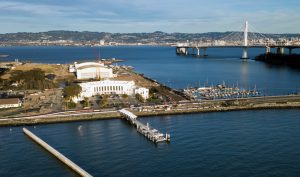
TREASURE ISLAND FERRY TERMINAL
Nearly three years after breaking ground, the new Treasure Island Ferry Terminal is now complete, paving the way and easier commute for as many as 24,000 new residents who are expected to call Treasure Island and Yerba Buena Island home by 2035.
Alameda-based heavy civil and marine contractor Power Engineering Construction Company finished the design-build terminal last March, a $33.6 million project that called for a ferry terminal with a fixed concrete pier, gangway and a steel float. The terminal links to land-based transportation at the foot of Treasure Island.
The work, which began in August 2019, also included a concrete breakwater. It consists of 815 lineal feet of “vertical precast concrete sheet piling with concrete batter piles every 6 to 18 feet for lateral load strength and a continuous concrete cap cast over both the batter and sheet piling,” according to the company.
Power Engineering, which has built four other ferry terminals in San Francisco Bay, said this new terminal is built for the future.
“The Treasure Island Ferry Terminal is the first to incorporate the infrastructure to go all electric with future upgrades,” project executive Wayne Stonecipher said. “On this project we worked with a private developer with very little marine experience, in a design-build capacity. It’s been rewarding because, as a team, what we delivered is an architecturally pleasing, fully-outfitted and protected marine terminal capable of servicing smaller private ferries as well as the robust public ferry system of the local Water Emergency Transportation Authority.”

